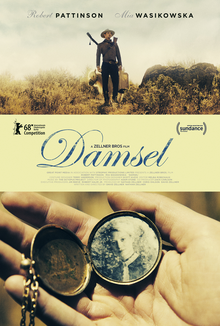| Damsel | |
|---|---|
 |
by Peter J. O'Connell
Damsel.Released: June 2018. Runtime: 113 mins. MPAA Rating: R for some violence, language, sexual material, and brief graphic nudity.
Damsel—written/directed/co-produced by and co-starring the Zellner brothers—has a premise that might have been developed into an advenure rescue movie set in the wild West. But that isn't what Damsel is. Damsel is an absurdist take on adventure rescue movies, and its setting is a very wacky West.
Absurdism might be briefly described as a minimalist approach to scenes that conventionally would be presented in a maximalist way and the use of dialogue delivered deadpan or with a different emotive quality than would be usual in a traditional drama. Absurdism treats the bizarre as if it were banal, and anachronisms, seeming non-sequiturs, and incongruities may abound. The aim is to upset expectations and explode cliches.
Damsel starts off with a scene that might almost be a kind of homage to a classical absurdist work, Samuel Beckett's Waiting for Godot. A wornout preacher (Robert Forster) in black garb is sitting next to a young man in long underwear at a sunbaked stagecoach stop in the wilderness—waiting. After some largely monosyllabic exchanges, the preacher suddenly gets up and runs off, shedding his clothes.
The next scene is of an enormously energetic—and entertaining—barn dance featuring a young couple, Samuel Alabaster (Robert Pattinson) and his fiancee, Penelope (Mia Wasikowska). Is this an allusion to the dance scenes in Westerns by John Ford and others?
The third scene gives us another jolt. It shows Samuel traveling in the far, very far West—the Pacific Ocean. He makes his way in a small boat through rough surf to a rugged beach. And he has a miniature golden pony, Daisy (played by Butterscotch), with him!
The fourth scene has Samuel, naïve and nerdy, arriving in a frontier town that looks left over from a spaghetti Wester or Clint Eastwood movie. Samuel enters a bar full of threatening characters, certainly a classic Western trope, except that the characters are physical and mental “misfits”, as the movie dubs them, more reminiscent of, say, the cantina scene in Star Wars than the Jack Palance character and his gunmen in Shane. Samuel explains that he has come to rescue Penelope, who has been kidnapped and taken into the wilderness, and marry her. The pony is to be a wedding gift.
Samuel leaves the town to continue his odyssey. As he does so, one of the misfits is hanged while a singer yodels. Soon Samuel encounters Parson Henry (David Zellner), dressed like the preacher from the first scene, though he isn't really a parson, just a drunken stumblebum. Samuel hires Parson Henry to accompany him and officiate at the wedding once Penelope is rescued.
Further summarizing of scenes probably isn;t necessary to give you a sense of the tone and techniques of the movie. What is necessary, though, is to highlight that when Samuel and Parson Henry finally reach Penelope, she may be in distress but is not really a “damsel.” Instead, she's become an empowered woman like her namesake in Homer, fending off various men, including: kidnappers; Samuel; Parson Henry; Rufus (Nathan Zellner), a deranged mountain man; and Zachariah (Joseph Billingiere), a Native American.
Mia Wasikowska brilliantly plays Penelope completely straight and, at times, terrifyingly violent. As she says: “I don't need anyone's saving!” Actually, Wasikowska's playing straight throws into high relief the absurd nature of the other characters—and, perhaps, of male attitudes about women.
Many will find Damsel annoyingly “crazy.” It's definitely not “your grandfather's Western,” whether you're a grandchild or a grandfather yourself. But, perhaps, the movie is crazy like a fox—or a miniature golden pony.
No comments:
Post a Comment